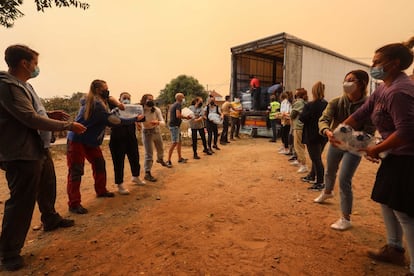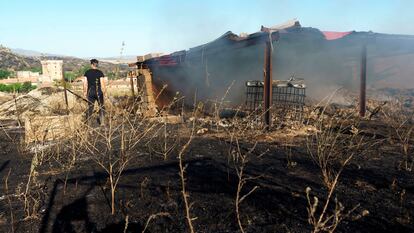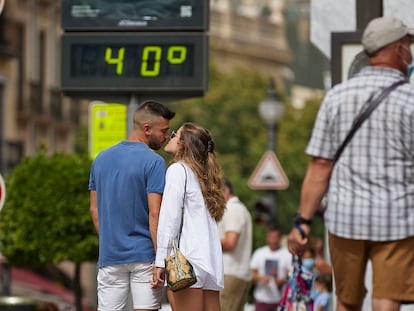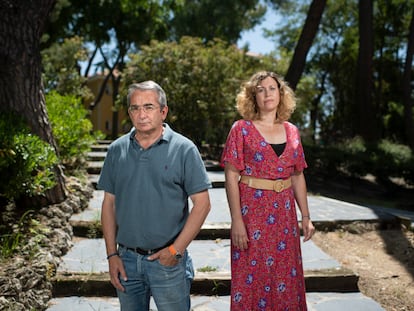Wildfire in Spain’s Ávila province continues to burn after razing 20,000 hectares of land
Three villages had to be evacuated due to the blaze, which is the largest to hit the Castilla y León region since 1984
A wildfire continued to burn across the Spanish province of Ávila in the northwestern region of Castilla y León on Wednesday, although it was coming under control. The blaze began on Saturday and was sparked after a car was set alight following an accident on the N-502 highway near the municipality of Navalcruz. It has since become the largest fire to hit Castilla y León since 1984, when the national government devolved powers to the region.
Juan Carlos Suárez-Quiñones, the head of the environment department in Castilla y León, said on Monday that the blaze was fueled by a “perfect storm” of factors: temperatures close to 40ºC during the heatwave in Spain (a record high for the area), less than 30% humidity (it dropped to 4%) and sustained winds of between 40 and 45 kilometers per hour, with gusts of up to 60 kilometers per hour.

According to the Ministry for Ecological Transition, the wildfire has a perimeter of 130 kilometers and has razed more than 20,000 hectares of land. Most of the area affected is made up of scrubland, oak, pasture and some pine. The most dangerous part of the fire is now at its southern front, near the municipalities of Navalacruz, Navaquesera, Villarejo and Navalmoral de la Sierra.
Three villages – Solosancho, Riofrío and Sotalbo – had to be evacuated on Sunday, although residents were able to return on Monday as the fire stabilized. But even in these areas, there are still fire hotspots. In Riofrío, for example, locals have been working to put out a fire at the edge of the village with whatever they can, including branches, water and sticks. The mayor, Pilar Galán, said the village was also getting help from firefighting aircraft such as water bombers “because the area is very rugged.” She explained: “We are on tenterhooks, when one goes out, another starts up again.” The mayor is also trying to find a way to help farmers feed their animals in the wake of the fire.

It’s an issue that is also facing Pedro Sansegundo del Peso, a livestock farmer in Navalmoral de la Sierra, where the blaze continued to flare up again despite being more or less under control. The wildfire has destroyed the warehouses where he kept animal feed as well as the farm where his cows would graze. “The only solution is to buy more feed and wait for spring to come, although it is going to be bad, because the fields are destroyed,” he said.
His son, who has the same name, is in Navalacruz, another one of the areas hardest hit by the blaze. By Tuesday afternoon, there were still small hotspots in the municipality, but the fire was fairly controlled. According to the younger Sansegundo del Peso, this was “thanks in large part to the work of the locals, who made firewalls with what they had” to prevent the blaze from spreading. Some built the structure by hand, while Sansegundo del Peso used his bulldozer. Others supported the workers by providing home-cooked meals. “I am proud of my people and my friends,” he said. According to him, 90% of pastureland in the area has been razed.

“The difficult job of controlling and extinguishing [the fire] remains,” said Alfonso Fernández Mañueco, the premier of Castilla y León, at a press conference on Tuesday morning. The regional leader said work was already underway to restore the area and help those affected by the blaze. He announced urgent measures aimed at preventing soil deterioration, forest diseases and rain from shifting land, as well as initiatives to protect water purity.
The minister for ecological transition, Teresa Ribera, said on Monday that forest fires are one of the “most significant” impacts of climate change. “We know that extreme meteorological events, extreme temperatures with ever more frequent heatwaves, together with significant changes to rainfall underscore the degree to which large wildfires, drought and desertification form part of the effects of climate change which we must fight against,” she said.
English version by Melissa Kitson.
Tu suscripción se está usando en otro dispositivo
¿Quieres añadir otro usuario a tu suscripción?
Si continúas leyendo en este dispositivo, no se podrá leer en el otro.
FlechaTu suscripción se está usando en otro dispositivo y solo puedes acceder a EL PAÍS desde un dispositivo a la vez.
Si quieres compartir tu cuenta, cambia tu suscripción a la modalidad Premium, así podrás añadir otro usuario. Cada uno accederá con su propia cuenta de email, lo que os permitirá personalizar vuestra experiencia en EL PAÍS.
¿Tienes una suscripción de empresa? Accede aquí para contratar más cuentas.
En el caso de no saber quién está usando tu cuenta, te recomendamos cambiar tu contraseña aquí.
Si decides continuar compartiendo tu cuenta, este mensaje se mostrará en tu dispositivo y en el de la otra persona que está usando tu cuenta de forma indefinida, afectando a tu experiencia de lectura. Puedes consultar aquí los términos y condiciones de la suscripción digital.
More information
Últimas noticias
Welcome to the post-religion era: The idea of Christianity as the absolute truth has become obsolete
‘I thought you would like it’: The risky sexual practice popularized by TV shows and TikTok
The digitalization of tourism: ‘They promise experiences and gave us the worst possible one’
Mexican peso defies uncertainty with forecasts of a new period of stability in 2026
Most viewed
- Sinaloa Cartel war is taking its toll on Los Chapitos
- Oona Chaplin: ‘I told James Cameron that I was living in a treehouse and starting a permaculture project with a friend’
- Reinhard Genzel, Nobel laureate in physics: ‘One-minute videos will never give you the truth’
- Why the price of coffee has skyrocketed: from Brazilian plantations to specialty coffee houses
- Silver prices are going crazy: This is what’s fueling the rally












































